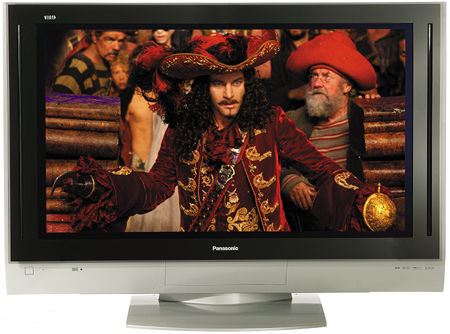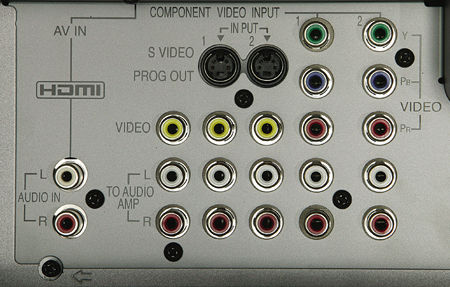Panasonic Viera TH-50PX25U/P HD plasma television

As Sony has with its Wega line of high-end displays, Panasonic has invented what appears to be a largely meaningless but supposedly catchy moniker, Viera, for the line that includes the 50-inch set reviewed here: the TH-50PX25U/P ($7999.95). There are also similar Viera models at 42 inches ($5999.95) and 37 inches ($4999.95). All three models (plus two less expensive standard-definition panels) include both NTSC and ATSC high-definition tuners for reception (with an antenna) of analog and digital over-the-air programming. All five sets also include a CableCARD slot so the TVs can receive digital cable programming without a cable box. Panasonic was the first company to receive Cable Labs' certification for this feature.
Beginning July 1, 2004, Panasonic and every other television manufacturer were required to build DTV receivers into 50 percent of all TVs with screens 36 inches or larger. A Panasonic executive told me early this year that the company hoped it could meet that requirement by building the receivers into all of its plasmas. To contain all this new hardware, the new sets are not quite as svelte as their predecessors: The TH-50PX25U/P's base (not its stand) is a silver panel almost 6 inches high, and the TV is thicker than earlier Panasonics or other plasmas I've seen. The last Panasonic 50-inch plasma I reviewed (favorably), in 2002, was 3.9 inches deep—typical for plasmas. This one is 5.5 inches deep.
I wouldn't call that fat, but the TH-50PX25U/P is noticeably more substantial than its predecessors. There's a good reason. The earlier model, the TH-50PHW3, was simply a monitor with neither an NTSC nor a DTV tuner; the only way to hear anything from it was to connect it to an outboard audio system—and it cost $4000 more than the TH-50PX25U/P.
This new model, however, is a full-fledged TV set. It can receive any over-the-air TV signal available, plus digital cable—and its four built-in, rear speakers sounded more than respectable for TV speakers, in case you don't feel like firing up the audio system to watch the 11 o'clock news. The TH-50PX25U/P can comfortably stand alone, unconnected to any other system. You'll enjoy it a lot more if you attach it to an outboard audio system, but that obvious fact applies to every high-end TV.
Handsome Visage
The TH-50PX25U/P is handsome. The screen and a thin frame around it are black, and an even thinner silver frame around that blends into the silver base. A door in the middle of the base opens to reveal several input jacks and two card slots, SD and PCMCIA, used for displaying digital photos onscreen. The TV's sophisticated software for handling that function is a nice feature. The set will show most pictures at full resolution. The native resolution for video and still images is 1366x768—more than enough to display 720p HDTV at full resolution.
Complete suites of analog and digital inputs grace the back panel, including two component-video inputs and one HDMI/HDCP jack. The latter conveys both digital audio and video from a source device to the display over a single cable.
I have no significant complaints about the programmable remote control. It's easy and intuitive to navigate, and it's completely backlit. Even better, the labels are printed on the buttons themselves—you can read them when the light is on. Some manufacturers backlight the buttons but print the labels on the casing next to them; in the dark, you see a host of illuminated buttons but have no way of knowing what each is supposed to do. My only quibble with this remote is that the light stays on for only one second. That's sure to preserve battery life, but I'm also certain you'll use up the battery faster by pushing the button two or three times whenever you try to send a command, which you must do to find what you need.
The TV includes a familiar host of so-called "picture-enhancing features," such as natural color and video noise reduction. As with all TVs, these are actually picture-busting features that distort or soften the image and are best left turned off.
However, one feature I'd never seen before caught my eye. Called color matrix, this feature theoretically compensates for the color shift that can occur when switching from NTSC to digital programming. In the early days of DTV, color and other picture settings were notably out of sync when switching to high-definition. Colors were far too vivid, and brightness was too high. In reviewing sets during those early days, other reviewers and I called for independent picture settings for each input so that, when switching to the DTV input, the needed adjustments could be made automatically.
In recent years, the problem has not been as bad. Perhaps programmers, who now have six years' experience with DTV, are making adjustments themselves; or perhaps DTV receivers are now designed to make this compensation. Based on my experience of the Panasonic TH-50PX25U/P, I now lean toward the latter theory.
When watching NBC's HD Olympics coverage, I saw no need for any particular adjustment of the TH-50PX25U/P. Still, I set out to see what color matrix would do. When I scrolled down through other adjustments at the bottom of the picture menu, the color matrix control was not highlighted—it was unavailable. Odd. I looked through the instructions, which told me that color matrix was available only for digital material fed to the TH-50PX25U/P through the component-video inputs.
That's peculiar. Were the TH-50PX25U/P a monitor requiring an outboard digital tuner, this would make sense. However, to offer a feature that doesn't work with the set's own built-in digital tuner is an unfortunate oversight. It's as if the software provided with this set is borrowed from an older version that did not have a built-in tuner.
Anyway, I connected my Sony HD-100 digital receiver to the Panasonic's component input just to see how this control works. The Sony is several years old and several generations behind the current state of the art. As portrayed by the Sony, the high-definition Olympics coverage did require color adjustment—the reds bloomed. I scrolled down to the color matrix control to see if it would adjust this properly, but it still was not available. With that, I gave up. Nice idea, but it didn't work on my review sample.
The menu system, colorful and easy to navigate, includes a well-designed setup menu and a signal meter for digital signals. First, I evaluated the sensitivity of the DTV receiver. Panasonic sold the very first DTV receiver back in fall 1998. I performed a channel search with this one, and it received all six digital channels available here in Washington, D.C., with no need for me to adjust my antenna. That seems to be the way with DTV receivers these days. When receivers were outboard boxes, you could upgrade occasionally as the technology improved. Now that they're increasingly going to be built-in, you're stuck with what you get. The TH-50PX25U/P's DTV receiver picked up more channels without problem than did its NTSC receiver, which could not seem to receive two UHF channels.
Performance
As is my usual practice, I introduced myself to the Panasonic by running through some test patterns from the Digital Video Essentials test DVD, which allowed me to set the black level and bring the picture into rough calibration. Right away, I spotted a problem I've seen on plasmas now and then, but never on a top-of-the-line Panasonic model: The TH-50PX25U/P was unable to present a uniform black picture. With a mostly black screen (the low-APL PLUGE pattern, in this case), the top third of the image was notably brighter than the bottom third. That made setting the black level a challenge: Do I set it for the black level at the top of the screen or at the bottom? I decided to wait until Jamie Wilson, of Overture Audio/Video in Delaware, had performed a color-temperature calibration and other adjustments to see if any of that would ameliorate or eliminate the problem. It didn't.
 As I said, I'd seen this problem with plasmas before. Jamie had too, but he said he could not remember a case this severe. Nothing we tried would correct it. That said, I could not easily see the problem with program material. I had to look carefully, sometimes even pausing the picture, to be sure. A dark bar that ran from top to bottom was a little lighter at the top. I'm not trying to excuse a serious issue, but its effect on regular viewing was minimal.
As I said, I'd seen this problem with plasmas before. Jamie had too, but he said he could not remember a case this severe. Nothing we tried would correct it. That said, I could not easily see the problem with program material. I had to look carefully, sometimes even pausing the picture, to be sure. A dark bar that ran from top to bottom was a little lighter at the top. I'm not trying to excuse a serious issue, but its effect on regular viewing was minimal.
Plasmas' usual weakness is their inferior black levels. I reviewed some of the very first plasmas on the market back in 1998, and they could do no better than medium gray. Since then, of course, all of them have improved, and the Panasonic TH-50PX25U/P represents today's state of the art: by my estimation, roughly 80 percent of the way toward the best CRT black.
Overall, the Panasonic's picture was quite pleasing, bright and vibrant. It exhibited significant "red push"—as do many TVs, to a greater or lesser extent. That is, when all colors are properly balanced, red remains overbearing. Turning the color saturation down throws other colors slightly out of balance. With this display, the result was that grays and blacks had a very slight green tinge.
The Panasonic's scaler was excellent. Most of the time, the picture was rock steady with little indication of artifacts—jagged lines or unnatural sparkle in irregular surfaces. I spotted a bit of sparkle now and then, but it was nothing serious. I watched the DVD of Hellboy with some friends; they marveled at the picture, and I found little fault.
High-definition programming—I watched NBC's HD coverage of the summer Olympics—was glorious, clear and vivid. I could pick out faces in the stands. As mentioned earlier, the Panasonic's tuner rendered colors just as they should be rendered, without any need to readjust for HD. Since the 1080i image had to be converted to this set's lower, native resolution, picture was not as perfect as HD can be. It looked sharp and clear, but it didn't look real—not like looking out a window.
Conclusion
Don't take my criticisms to mean I didn't like Panasonic's Viera TH-50PX25U/P. I did. Its color matrix feature didn't work, and the set showed various picture problems that were generally not visible when watching regular programming. More than anything else though, Panasonic's latest top-of-the-line plasma TV offered a large, stunning picture that is sure to please.













































